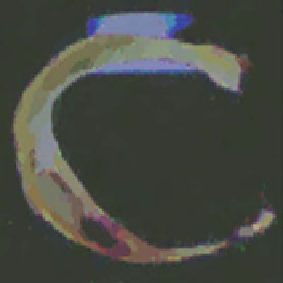Image Processing Reference
In-Depth Information
vertex. To detect higher-density clusters within each cluster, all cells containing the
minimum number of points in this cluster are removed and one detects among the
remaining cells, again, largest sets of neighboring cells. This step may lead to split-
ting of a cluster into multiple higher-density clusters. This process is iterated until
no more clusters split. Recording the splitting information, one obtains the cluster
hierarchy. Those clusters that do not split anymore represent local maxima and are
referred to as mode clusters. The approach scales well with the number of dimen-
sions, since only non-empty cells are being stored. Moreover, it is quite efficient,
since the histogram is computed by iterating over the dimensions and subdividing
the non-empty cells only. For a detailed analysis and comparison of this clustering
approach to other clustering approaches, we refer to the thesis by Long [
40
]. In par-
ticular, it is shown that this clustering approach is capable of extracting clusters of
any shape including clusters with concave areas and even holes.
Another suitable approach for defining clusters in multivariate volume data is to
use statistical methods to evaluate correlations between the different attributes and
identify regions of the object space with matching correlations. Jänicke et al. [
19
]
propose to use mutual information to detect regions of a certain behavior in multi-
variate volume data. This approach is not anymore build upon the idea of clustering
in attribute space but rather on segmenting the object space directly. Similarly, one
can also apply standard segmentation algorithms and generalize them such that they
can deal with multivariate volume data. Ivanovska [
16
] presented a segmentation
approach based on the concept of minimum description length of the encoding of the
segments. It can be derived from information theory that the segmentation with min-
imum description length for the segments boundaries represents an optimum. The
original idea was extended to a multivariate setting, where the minimum description
length takes into account all attributes such that the optimization strives for getting
the segments boundary to coincide. Figure
16.1
shows a result of the approach.
Fig. 16.1
Automatic segmentation of multivariate medical imaging data: segments are derived
from three attributes obtained using T1-, T2-, and T2
∗
-weighted MRI imaging of plaque using a
multivariate version of the minimum description length approach. Segments are shown as regions of
constant color. (Data courtesy of Andreas Harloff and Michael Markl, University Hospital Freiburg,
Germany.)


Search WWH ::

Custom Search